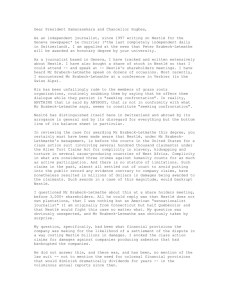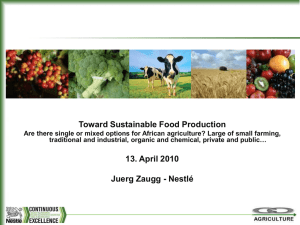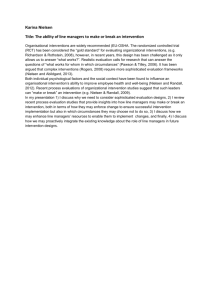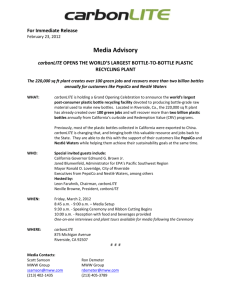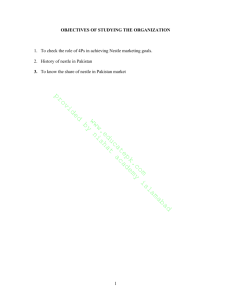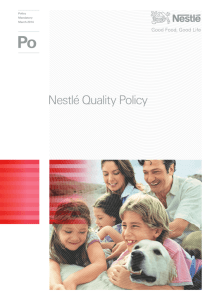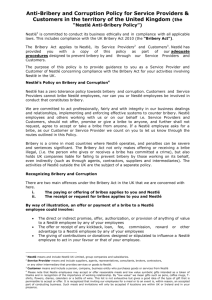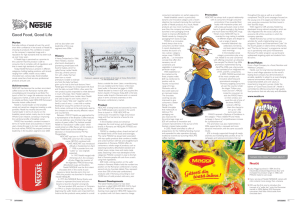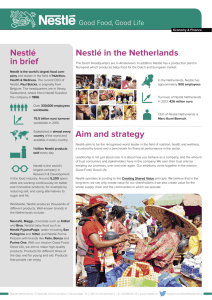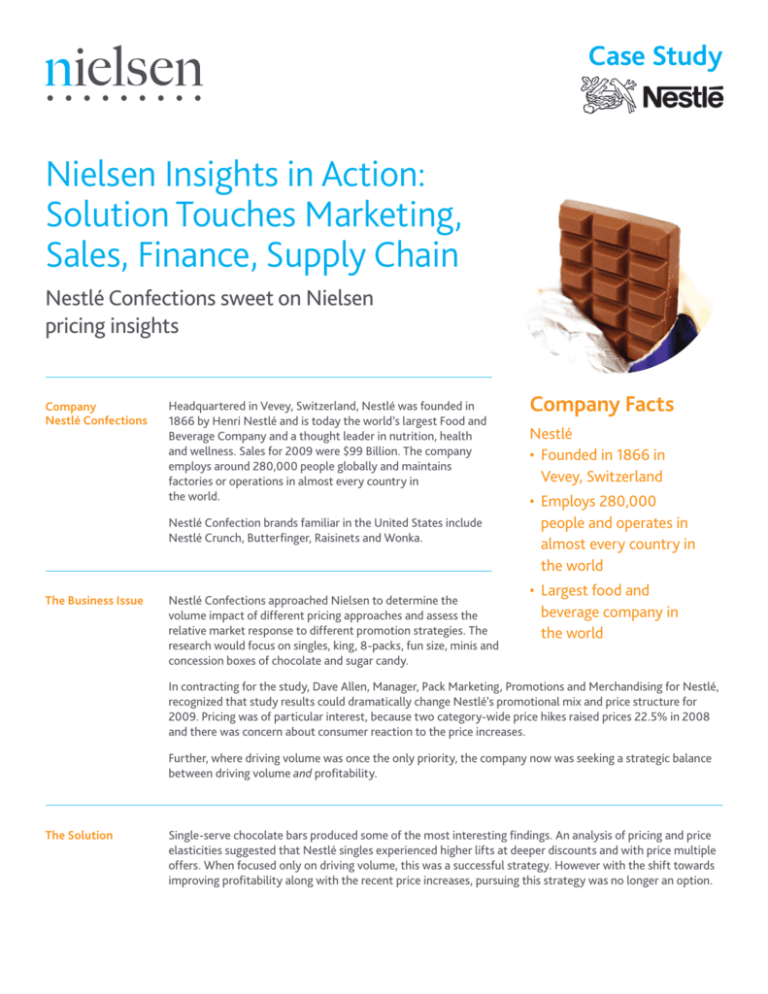
Case Study
Nielsen Insights in Action:
Solution Touches Marketing,
Sales, Finance, Supply Chain
Nestlé Confections sweet on Nielsen
pricing insights
Company
Nestlé Confections
Headquartered in Vevey, Switzerland, Nestlé was founded in
1866 by Henri Nestlé and is today the world’s largest Food and
Beverage Company and a thought leader in nutrition, health
and wellness. Sales for 2009 were $99 Billion. The company
employs around 280,000 people globally and maintains
factories or operations in almost every country in
the world.
Nestlé Confection brands familiar in the United States include
Nestlé Crunch, Butterfinger, Raisinets and Wonka.
The Business Issue
Nestlé Confections approached Nielsen to determine the
volume impact of different pricing approaches and assess the
relative market response to different promotion strategies. The
research would focus on singles, king, 8-packs, fun size, minis and
concession boxes of chocolate and sugar candy.
Company Facts
Nestlé
• Founded in 1866 in
Vevey, Switzerland
• Employs 280,000
people and operates in
almost every country in
the world
• Largest food and
beverage company in
the world
In contracting for the study, Dave Allen, Manager, Pack Marketing, Promotions and Merchandising for Nestlé,
recognized that study results could dramatically change Nestlé’s promotional mix and price structure for
2009. Pricing was of particular interest, because two category-wide price hikes raised prices 22.5% in 2008
and there was concern about consumer reaction to the price increases.
Further, where driving volume was once the only priority, the company now was seeking a strategic balance
between driving volume and profitability.
The Solution
Single-serve chocolate bars produced some of the most interesting findings. An analysis of pricing and price
elasticities suggested that Nestlé singles experienced higher lifts at deeper discounts and with price multiple
offers. When focused only on driving volume, this was a successful strategy. However with the shift towards
improving profitability along with the recent price increases, pursuing this strategy was no longer an option.
Nielsen Insights in Action:
Optimize Promotion, Achieve
Category Growth
The analysis uncovered that shallower discount offers yielded
higher spending efficiencies than deeper discounts where no
lump sum fees were paid to grocers for displays or feature ads.
Retailers began to waive the ad fees, making up the difference
by forward buying—requiring special pricing for a month,
committing to just two weeks of promotion, then loading up
on product at the lower price. Nestlé used the study to better
understand and control this practice.
Nielsen made several recommendations for single-serves.
First, set the lowest price discount necessary to secure retailer
support for feature ads and displays in accounts that do not
charge ad fees. In accounts that do charge ad fees, run deeper
discounts with accompanying feature and display activity to
offset the fixed fees. Additionally, test special offers and gauge
the effectiveness of price multiples at higher price points where
the competition was not aggressively promoting.
Nielsen adapted its global price promotion simulator to help
Nestlé model alternative market scenarios factoring in volume,
profit, retailer profit, trade spending levels and other metrics.
A Win-win
Outcome
Case Study
“Nielsen brought a true
management perspective
to the table, looking
beyond just the marketing
implications of price and
promotion, to the financial
and operational aspects of
their recommendations.
They helped us develop a
consumer-driven approach
to marketing decisions
that helped us improve
margins across the
portfolio and improve ROI
on trade spend.”
-Dave Allen, Manager, Pack
Marketing, Promotions and
Merchandising, Nestlé Confections
The Nielsen approach provided an understanding of price
elasticities and the impact of trade promotions on Nestlé’s
volume. These learnings confirmed that chocolate packs had much different price elasticities than sugar thus
allowing Nestlé to develop an improved plan to optimize the trade strategy across the Chocolate and
Sugar portfolio.
Study findings convinced Nestlé senior management that lower volume forecasts for 2009 were reasonable
to expect, a fact confirmed when actual sales results landed within 2-3 percent of projections.
At year end 2009, Nestlé reaped significant margin gains, despite volume declines. This fundamental shift in
strategy delivered the best results for Nestlé Confections in many years. Changing the emphasis to include
profit goals enabled Nestlé to re-set volume expectations with operations and management. Nestlé now
cites this study as a best practices example that enabled them to more precisely calibrate production and
supply chain forecasts to changing market realities.
To learn more about how Nielsen can help with your pricing and promotion
strategies, contact sales.us@nielsen.com or visit www.nielsen.com
Copyright © 2011 The Nielsen Company. All rights reserved. Printed in the USA. Nielsen and the
Nielsen logo are trademarks or registered trademarks of CZT/ACN Trademarks, L.L.C. Other product
and service names are trademarks or registered trademarks of their respective companies. 11/1863

